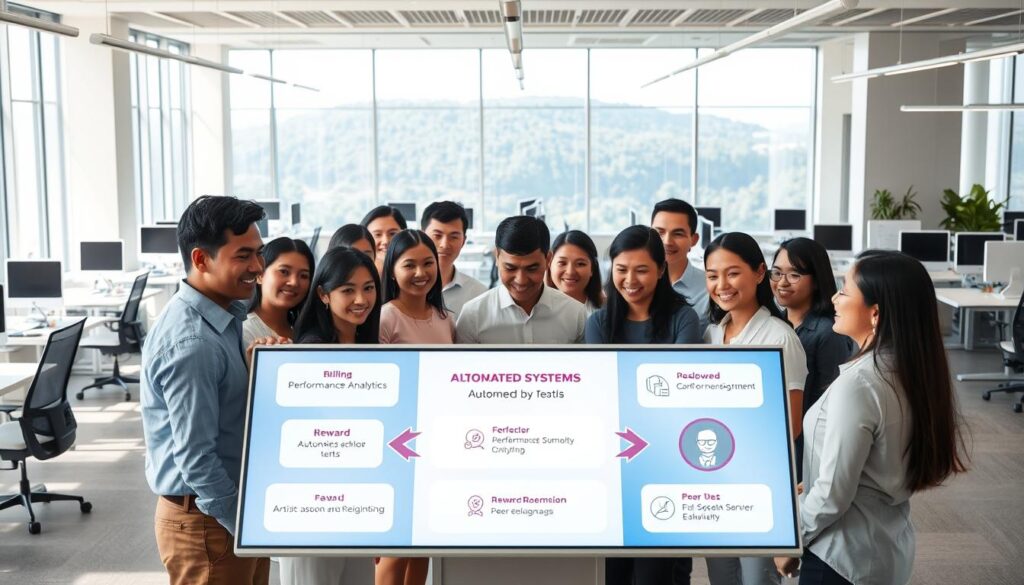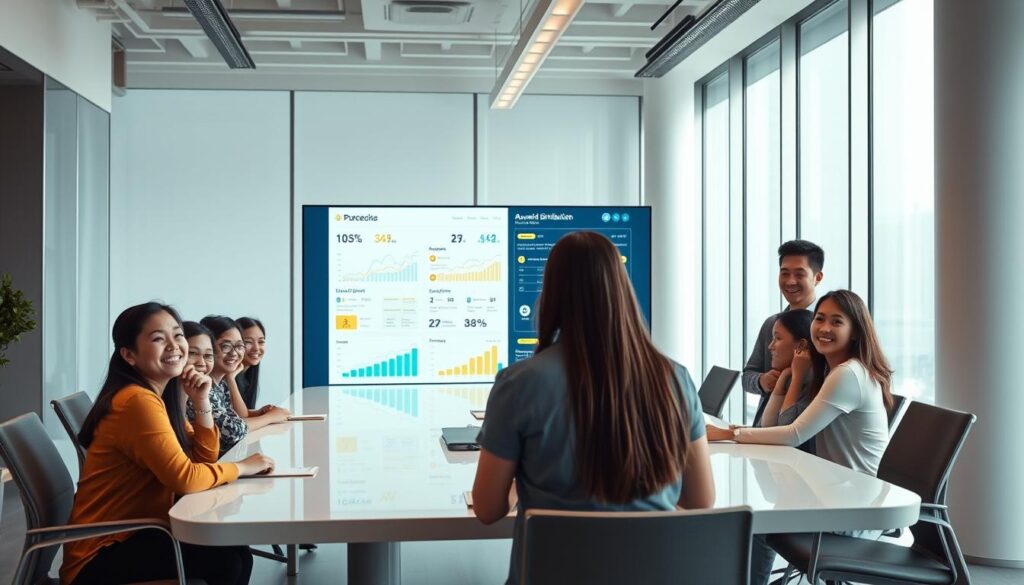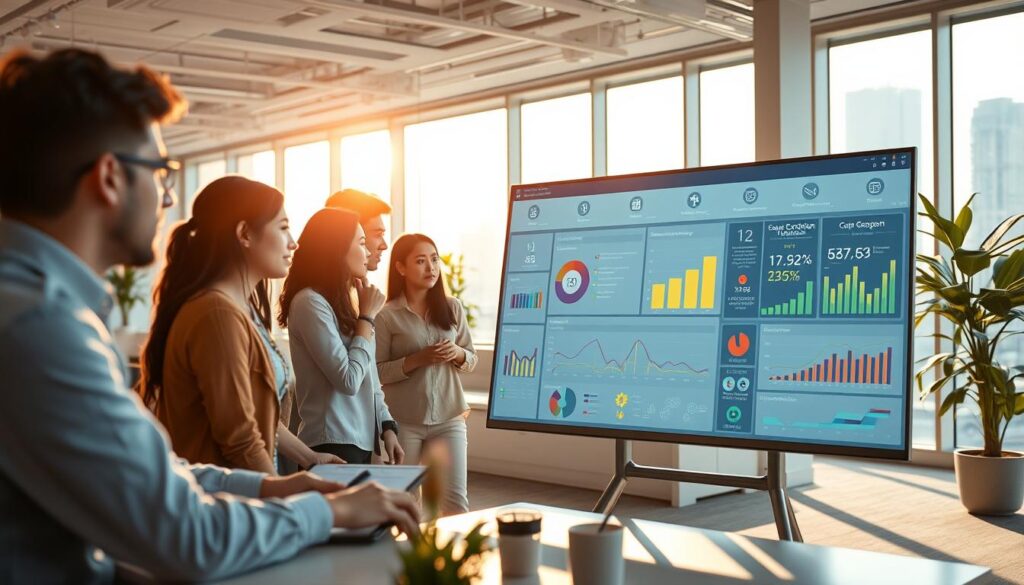Have you ever wondered why some companies seem to engage their employees better than others? In today’s fast-paced world, it’s key to link employee recognition with automated systems. This combo boosts morale, productivity, and keeps employees happy. For small to medium-sized businesses, knowing how to do this can really help keep staff happy and loyal.
We’ll dive into what makes employee recognition work and how automation helps. You’ll learn how to mix your current tools with personalized recognition. This can change how your workplace feels and motivate everyone to do their best.
Also, using automated systems with recognition can lead to big wins. It can really change the work environment for your team.
Key Takeaways
- Integrating automated systems streamlines employee recognition processes.
- Employee engagement directly affects talent retention and productivity.
- Personalizing recognition efforts enhances their impact.
- Effective use of data can tailor recognition to individual preferences.
- Timely acknowledgment strengthens workplace relationships.
- A culture of recognition fosters a more positive working environment.
The Importance of Employee Recognition Programs
Employee recognition programs are key to making workplaces better and happier. They create a culture where everyone feels appreciated. This makes people feel more connected and motivated to do their best.
Boosting Morale and Workplace Satisfaction
Being appreciated makes people happier at work. Awards, shout-outs, and public thanks boost this feeling. It makes employees feel more connected to the company’s goals.
This positive feeling spreads, making the workplace a better place. When people feel their work is valued, they dive into their jobs with more enthusiasm.
Employee Retention and Productivity
Recognizing employees helps keep them around longer. Companies that celebrate their achievements build a loyal team. This reduces turnover and makes teams work better together.
As a result, work gets done more efficiently. This can also help a company’s profits grow. It shows that investing in employee recognition is smart.
Understanding Automated Systems in Employee Recognition
Automated systems are key in making employee recognition better. They work well with other tools used in the workplace. This makes it easier to show appreciation while keeping things personal.
Automation helps send thanks right away. This makes employees feel valued and appreciated more.
Integration with Existing Workforce Tools
Good employee recognition comes from using automated systems with what’s already there. This mix makes it easier to say thanks and boosts team spirit. For instance, when someone hits a milestone, the system can send a special message.
This makes everyone feel more connected and encourages them to do their best.
Automation Enhancements in Recognition
Using automation in recognition programs makes a big difference. It does more than just send messages. It looks at data to find out who’s doing great and rewards them based on their work.
This keeps everyone motivated and helps HR do less work. It makes recognition more efficient and meaningful.

| Feature | Manual Systems | Automated Systems |
|---|---|---|
| Response Time | Delayed | Immediate |
| Customization | Limited | High |
| Data Analysis | Manual Review | Automated Insights |
| Administrative Burden | High | Reduced |
Personalizing Employee Recognition Efforts
Creating a personalized recognition strategy makes a big difference. It shows employees they are valued, leading to a stronger commitment. Using data analytics helps make recognition efforts more effective, focusing on what each employee likes and does well.
Using Data to Tailor Recognition
Data analytics is key in finding out what really motivates employees. By looking at performance and feedback, companies can create recognition that truly connects with their team.
- Identify top performers based on sales data and craft messages that specify their contributions.
- Track employee milestones such as anniversaries or project completions to deliver timely acknowledgments.
- Utilize surveys to gather preferences on recognition styles, allowing for customization that aligns with individual expectations.
Creating Impactful Messages for Employees
Thoughtful messages make recognition more meaningful. When employees see their achievements acknowledged, it builds loyalty and boosts engagement. Writing unique messages for different occasions can turn a simple thank you into a memorable moment.
| Occasion | Type of Message | Example |
|---|---|---|
| Birthday | Personalized Note | “Wishing you a fantastic birthday, [Employee Name]! Your contributions have made this year brighter!” |
| Work Anniversary | Achievement Acknowledgment | “Congratulations on your [X] years with us, [Employee Name]! Your dedication is an inspiration to all of us.” |
| Project Completion | Thank You Message | “Great job on completing the [Project Name], [Employee Name]! Your hard work and creativity did not go unnoticed.” |
Employee Engagement and Its Connection to Recognition
It’s key to understand how employee engagement and recognition work together. Recognition plays a big role in how employees feel at work. When they get thanks for their work, they feel more connected and loyal to the company.
How Recognition Drives Employee Engagement
Recognition boosts engagement by showing appreciation for good work. Teams with strong recognition programs have better morale and commitment. Seeing their efforts valued motivates employees to do even more, leading to better work and happiness.
The Role of Feedback in Employee Engagement
Quick and clear feedback is important for keeping employees engaged. Tools that let people thank each other help share recognition fast. This feedback not only shows appreciation but also helps employees grow and improve in their jobs.
Utilizing AI for Timing and Precision in Recognition
AI is changing how we recognize employees, making sure they feel valued at the right time. It helps spot the perfect moments to celebrate their achievements. This boosts motivation and teamwork.
How AI Identifies Key Moments
AI looks at how well employees do and their habits to find important moments. It knows when someone hits a sales goal or finishes a project early. This lets managers give thanks in a meaningful way, making everyone feel better.
Benefits of Timely Acknowledgment
When we thank employees right when they do something great, they feel more appreciated. This makes them want to keep doing good work. It’s really helpful for teams that are spread out, like sales teams in the Philippines.
Quick thanks make people feel part of the team. It makes them happier and more loyal to the company.
Streamlining Reward Distribution through Automation
In today’s fast-paced work world, giving rewards is key to making employees feel valued. Automation tools are now vital for making this process smooth. They help companies quickly give out bonuses, gift cards, and other rewards.
Digital Platforms for Quick Reward Allocation
Digital platforms make giving out rewards fast and easy. They let HR teams focus on other tasks while rewards get to employees fast. This way, everyone gets their rewards without any hiccups.
Automation cuts down on manual work and mistakes. This makes the whole process better for everyone. Quick rewards make employees feel truly appreciated, boosting the company’s culture.
Creating an Efficient Acknowledgment Process
Automation makes it easier to recognize employees’ hard work. When rewards come quickly, it shows employees their efforts are noticed and valued. This boosts motivation and teamwork.
Companies using automated systems see better engagement and retention. Employees feel seen and valued, leading to a happier workplace.

Enhancing Social Recognition with Internal Networks
In today’s workplace, social recognition is key to a positive culture. Using internal networks can take this recognition to the next level. Tools like Slack and Microsoft Teams help share achievements, building a sense of community and support.
Automated Sharing Across Communication Platforms
Systems that share updates automatically make sure everyone knows about achievements. They post about individual and team wins, reaching more people in the company. When people reply or react to these posts, it makes recognition a regular part of work life.
Encouraging Peer-to-Peer Acknowledgment
When coworkers praise each other, it boosts morale. It shows that everyone’s efforts are valued. By asking team members to share appreciation, we build stronger bonds and a sense of unity.
Real-Time Analytics for Evaluating Recognition Programs
Using real-time analytics can make recognition programs in companies much better. It helps gather insights on how well employees are engaged and how recognition affects work. This way, companies can see which strategies work best.
Gathering Insights on Engagement and Effectiveness
Analytics let companies look into important data about recognition programs. Key points include:
- How many people take part in recognition efforts
- How happy employees are with the recognition they get
- How recognition affects job performance
By understanding these, companies can see where to improve. This ensures recognition is truly valued and celebrated.
Adjusting Strategies Based on Analytical Data
With data from analytics, changing recognition strategies is easy. For example, if data shows peer-to-peer recognition is more effective, companies can focus on it. This flexibility is key in changing work environments, helping to boost employee engagement.

Emerging Technologies in Employee Recognition
The world of employee recognition is changing fast. New technologies are making it more fun and meaningful. Companies are finding cool ways to celebrate their team’s wins, making the workplace better and more motivating.
One big player is augmented reality.
Integrating Augmented Reality Celebrations
Augmented reality (AR) brings a new twist to celebrating employee milestones. It lets companies throw virtual parties that everyone can join, no matter where they are. This makes everyone feel included and seen.
Using AR in celebrations makes the event unforgettable. It boosts motivation and makes the celebration a highlight of the year.
Using Digital Badges for Visibility
Digital badges are another great way to show off what employees have achieved. They act as a badge of honor, boosting employee pride. On digital platforms, employees can display their badges, showing off their accomplishments.
This practice attracts top talent, which is key for small and medium-sized enterprises (SMEs) in the Philippines. It’s all about creating a cool work culture. Companies can also use badges as part of their efforts to boost productivity and engagement.
Digital badges and augmented reality are game-changers for employee recognition. They keep the excitement alive, making a big difference in how happy and engaged employees are at work.
Creating a Culture of Recognition in the Workplace
A great workplace culture values recognition for all employees. It creates an environment where everyone’s efforts are noticed and appreciated. This boosts morale and productivity.
When achievements are celebrated, employees feel important. This leads to higher engagement across the company.
Recognizing All Levels of Employees
It’s key to recognize everyone, not just the top leaders. Acknowledging small wins shows that every role matters. This makes the workplace culture strong and inclusive.
Setting Clear Criteria for Recognition
Having clear rules for recognition is vital. It helps employees understand what’s valued. This way, everyone knows what to aim for.
By setting clear goals, you create a fair and motivating work environment. This boosts employee engagement and performance.

Training Managers and Team Leaders on Recognition Practices
Training managers and team leaders is key to good recognition practices. Leaders set the tone for appreciation in a company. With the right training, they can easily spot and thank employees for their hard work.
This creates a culture where everyone feels valued. It boosts happiness among employees.
Importance of Leadership in Recognition
Leaders are the heart of recognition in a company. When they value employees, it makes everyone feel important. This approach boosts morale and productivity.
Managers need to know how to truly appreciate employees. This makes each thank you count.
Workshops for Effective Recognition Communication
Workshops on recognition can really help managers. They learn how to share thanks in many ways. This makes sure the message gets through to employees.
Training them to give specific, personal thanks is crucial. It makes them better at showing appreciation. This leads to a happier, more united team.
Conclusion
Using automated systems with employee recognition programs is key in today’s business world. It makes employees happier, more productive, and helps keep them. Automation makes it easier to show appreciation to everyone in the team.
For small businesses in the Philippines, using new tech for appreciation can really pay off. These systems make it easy to thank employees in a way that feels personal. This can change how teams feel about their work and each other.
Always recognizing what employees do makes the workplace better. It helps businesses succeed over time. By focusing on employee happiness, companies can build strong teams ready for anything.
FAQ
Why are employee recognition programs important for SMEs?
Employee recognition programs boost happiness and motivation at work. They make people feel part of the team. This is very important for SMEs to keep good workers in a tough job market.
How can automated systems improve recognition programs?
Automated systems make recognition easier by working with other work tools. They send out thanks quickly and in a way that feels personal. This makes the job of HR teams easier and lets them focus on big plans.
What role does personalization play in employee recognition?
Making recognition personal is key to making employees feel special. Custom messages for big moments make a big difference. It makes people feel more connected and loyal to the company.
How do real-time analytics benefit recognition programs?
Real-time analytics give insights into how well recognition is working. They show how engaged employees are and how often they get recognized. This helps companies make their recognition efforts better.
What are examples of technologies that enhance employee recognition?
New tech like augmented reality can make virtual celebrations feel real. It strengthens bonds and makes recognition more special. Digital badges also remind people of their achievements, boosting pride and drive.
How can social recognition be amplified within organizations?
Social recognition can grow by sharing on platforms like Slack or Microsoft Teams. These systems can post achievements automatically. This encourages everyone to celebrate each other’s wins, creating a supportive work place.
Why should all levels of employees be recognized?
Recognizing everyone helps build a fair and inclusive culture. It shows that everyone matters and helps create a positive work environment. This is key to keeping employees happy and loyal.
What is the importance of training managers in recognition practices?
Training managers in recognition is vital because they set the example. Workshops teach them how to thank employees well. This makes them feel confident in showing appreciation for their hard work.